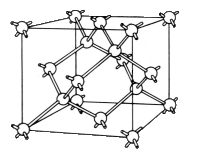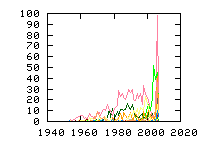« Previous
1
Next »
(9 hits, 1/1)
Showing
10, 25, 50, 100, 500, 1000, all papers per page.
Sort by:
last publication date,
older publication date,
last update date.
- 1. Appl. Phys. Lett. 91, 133507 (2007) , “Identification of atomic-scale defect structure involved in the negative bias temperature instability in plasma-nitrided devices”, J. P. Campbell, P. M. Lenahan, A. T. Krishnan, and S. KrishnanWe utilize a very sensitive electron spin resonance technique called spin-dependent tunneling to identify defect centers involved in the negative bias temperature instability in plasma-nitrided p-channel metal-oxide-silicon field-effect transistors. The defect's 29Si hyperfine... (Read more)
- 2. J. Appl. Phys. 99, 113506 (2006) , “Theoretical properties of the N vacancy in p-type GaN(Mg,H) at elevated temperatures”, S. M. Myers, A. F. Wright, M. Sanati, and S. K. EstreicherThe elevated-temperature properties of the N vacancy in Mg-doped, p-type GaN containing H were modeled using atomic-configuration energies and phonon densities of states obtained with density-functional theory. This study encompassed both equilibrium thermodynamics and the rates of diffusion... (Read more)
- 3. Phys. Rev. B 74, 144432 (2006) , “Role of defects in ferromagnetism in Zn1−xCoxO: A hybrid density-functional study”, C. H. PattersonExperimental studies of Zn1−xCoxO as thin films or nanocrystals have found ferromagnetism and Curie temperatures above room temperature and that p- or n-type doping of Zn1−xCoxO can change its magnetic... (Read more)
- 4. Microelectron. Reliability 45, 57 (2005) , “Characterization of interface defects related to negative-bias temperature instability SiON/Si<100> systems ”,Interface defects related to negative-bias temperature instability (NBTI) in an ultrathin plasma-nitrided SiON/ Si<100> system were characterized by using conductance–frequency measurements, electron-spin resonance measure- ments, and synchrotron radiation X-ray photoelectron spectroscopy. It was confirmed that NBTI is reduced by using D2-annealing instead of the usual H2-annealing. Interfacial Si dangling bonds (Pb1 and Pb0 centers) were detected in a sample subjected to negative-bias temperature stress (NBTS). Although we suggest that NBTS also generates non-Pb defects, it does not seem to generate nitrogen dangling bonds. These results show that NBTI of the plasma-nitrided SiON/Si system is predominantly due to Pb depassivation. Plasma nitridation was also found to increase the Pb1/Pb0 density ratio, modify the Pb1 defect structure, and increase the latent interface trap density by generating Si suboxides at the interface. These changes are likely to be the causes of NBTI in ultrathin plasma-nitrided SiON/Si systems. (Read more)
- 5. J. Appl. Phys. 95, 4096 (2004) , “Nitridation effects on Pb center structures at SiO2/Si(100) interfaces ”,Interfacial defect structures of NO-nitride oxide on Si(100) were characterized by electron spin resonance spectroscopy. We confirmed that the effective g values of the Pb1 center are affected by interfacial nitridation even at a small nitrogen concentration of 5 at. %, while those of the Pb0 center proved to be unchanged. We observed that the shifted Pb1 line appeared gradually with interfacial nitrogen concentration, which suggests that the nitrogen-induced modified structure substitutes for the original Pb1 structure. Angular variations of the shifted Pb1 lines were also significantly different from those of pure oxide. Based on our analysis, we attributed the g value shift of the Pb1 center to dangling bond tilting, caused by the displacement of nearest-neighbor Si atoms. (Read more)
- 6. Appl. Phys. Lett. 82, 3677-3679 (2003) , “Interface defects responsible for negative-bias temperature instability in plasma-nitrided SiON/Si(100) systems”, Shinji Fujieda, Yoshinao Miura, and Motofumi SaitohInterface defects generated by negative-bias temperature stress (NBTS) in an ultrathin plasma- nitrided SiON/Si(100) system were characterized by using D2 annealing, conductance-frequency measurements, and electron-spin resonance measurements. D2 annealing was shown to lower... (Read more)
- 7. J. Appl. Phys. 94, 1 (2003) , “Negative bias temperature instability: Road to cross in deep submicron silicon semiconductor manufacturing”,We present an overview of negative bias temperature instability (NBTI) commonly observed in p-channel metal–oxide–semiconductor field-effect transistors when stressed with negative gate voltages at elevated temperatures. We discuss the results of such stress on device and circuit... (Read more)
- 8. Phys. Rev. Lett. 90, 137402 (2003) , “Vacancy Defects as Compensating Centers in Mg-Doped GaN”, S. Hautakangas, J. Oila, M. Alatalo, K. Saarinen, L. LIszkay, D. Seghier, H.P. GislasonWe apply positron annihilation spectroscopy to identify VN–MgGa complexes as native defects in Mg-doped GaN. These defects dissociate in postgrowth annealings at 500–800 °C. We conclude that VN–MgGa complexes contribute to... (Read more)
- 9. phys. stat. sol. (a) 162, 95-151 (1997) , “EPR and ENDOR Investigations of Shallow Impurities in SiC Polytypes”, S. Greulich-WeberInvestigations of nitrogen donors in 6H-, 4H- and 3C-SiC using conventional electron paramagnetic resonance (EPR), electron nuclear double resonance (ENDOR) and optical detection of EPR and ENDOR as well as optical absorption and emission spectroscopy are reviewed and critically discussed. An... (Read more)
« Previous
1
Next »
(9 hits, 1/1)
Showing
10, 25, 50, 100, 500, 1000, all papers per page.
Sort by:
last publication date,
older publication date,
last update date.
All papers (3399)
Updated at 2010-07-20 16:50:39
Updated at 2010-07-20 16:50:39
(view as: tree
,
cloud
)
| 1329 | untagged |
Materials
(111 tags)
Others(101 tags)
Technique
(46 tags)
Details
(591 tags)
Bond(35 tags)
Defect(interstitial)(18 tags)
Defect(vacancy)(15 tags)
Defect-type(19 tags)
Element(65 tags)
Energy(8 tags)
Isotope(56 tags)
Label(303 tags)
Sample(17 tags)
Spin(8 tags)
Symmetry(15 tags)

